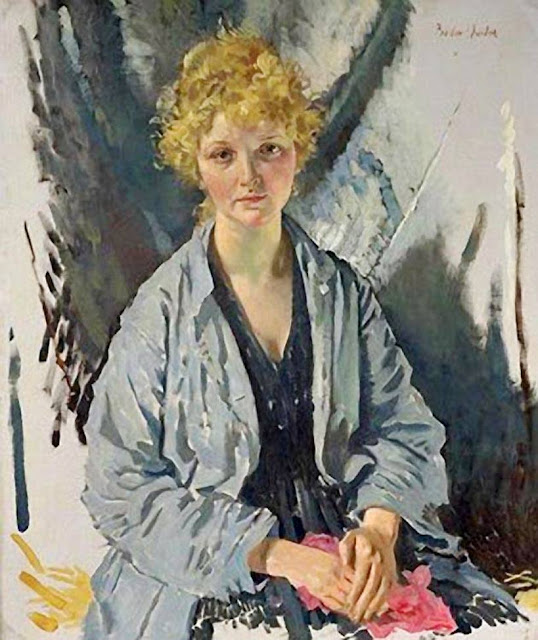Model Writing Postcards (1906)
Here is a lovely watercolour by influential Swedish painter Carl Larsson. It is a lovely image of a model taking a break from posing to write some postcards (the emails of the day - Europeans sent huge numbers of postcards to each other at the beginning of the twentieth century).
The Model on the Table (1906)
In the foreground can be
seen another painting by Larsson, Model on the Table, which
depicts a real (perhaps the same) model posing on a table with a couple of
mannequins.
Reclining Nude on Blue Sofa
Carl Larsson (1853-1919) was brought up in a very
poor family and his scholarship from a special poor school to the Royal Swedish
Academy of Arts provided him with a real escape from an unsettled and
unpleasant childhood. While studying in Stockholm he also worked as a caricaturist
and graphic artist for several Swedish newspapers, earning enough to
support his destitute parents.
Nude with grapes (1872)
Larsson had already developed a facility for drawing
the nude and earned a medal from the Academy for his nude drawing. This
example, done when he was nineteen, shows an idealised classical style, so
different from his later, realistic, illustrative style.
Karin Larsson
After several years working as a book illustrator,
he moved to Paris but did not get on with the French artistic scene. In 1882 he
moved to Grez-sur-Loing, a Scandinavian artists' colony outside Paris and
developed his distinctive watercolour style. It was there that he met his
future wife, another artist, the beautiful and talented, Karin Bergöö.
They got married the following year and their first child (of eight) was born
the year after that.
Leontine, Bare Backed Sitting in the
Studio (1902)
Leontine standing (1902)
They returned to Sweden and, luckily for them,
Karin's father was a wealthy businessman who bought them a cottage in the
village of Sundborn, where her father had been born.. The couple
decorated it themselves in a mixture of British Arts and Crafts style (they
subscribed to The Studio, the movement's magazine), Swedish
folk design and Japanese style, influenced by the popular prints of the time.
The biggest influence, however, was Karin who employed her artistic
skills to design and weave fabrics for the house. She also designed
furniture, working with local craftsmen. Eschewing the usual gloomy, dark
Swedish style of the time they created a home full of light and colour.
Rose and Back
Lisa with Flower Pot (1910)
My Wife
The English style, wild garden was becoming popular
in Sweden at the time and gardens became places to relax and enjoy the outdoors
rather than just somewhere to grow vegetables. Karin loved her garden and her
flower arrangements often appear in Carl's paintings (as in the right of Model
Reading Postcards).
When the Children Have Gone to Bed (1895)
It was also Karin who gave Carl the idea of doing
paintings of the interiors of their house and these pictures were released as
prints and in books. The first of these, Ett Hem (A
home), published in 1898, is still in print today. It was the
technological developments in colour printing, from 1890, which enabled Larsson
to produce prints and albums of his work, enhancing his reputation,
considerably.
In 1909 a German publisher produced another book of his work called Das
Haus in der Sonne featuring Larsson's drawings and paintings of
their house. It sold 40,000 copies in three months and since then
has been reprinted more than 40 times. It showcased the Larsson's ideas
about interior decoration to the world.
Larsson's House in the Sun
The Larsson's house, Lilla Hyttnäs,
today (the part of the house in the painting is at the far left)
This book created the new 'Swedish Style' which has
been so influential on interior designers ever since. Every time you see
painted old furniture or blue or green pastel painted wooden walls in someone's
house it is because of the Larssons. The Larsson's house became so famous that
people came to visit it as tourists. Their home, preserved as it was, in
still owned by their family and is now open to the public in the summer.
It receives about 60,000 visitors a year.
Girl crouching (1911)
Apart from his nudes and interior studies Larsson was a wonderful portraitist,
often using his children as subjects. He also produced book
illustrations, landscapes and other pictures of the village and countryside
where he lived.
Midvinterblot (1914)
Despite the popularity of his domestic interior watercolours, Larsson believed
that his own best works were his large murals. He had produced three of these
for the Swedish National Museum's interior but the final one, which he
considered his masterpiece, Midvinterblot (Midsummer
Sacrifice), was rejected by the museum's board. The controversy split
the Swedish art establishment and even the government became involved.
The rejection of the picture hit Larsson hard and he suffered from bouts
of depression. The historical subject was considered not appropriate for
Sweden's new modern view of itself at the time. Eventually, it was sold to a
Japanese collector in 1987 who then lent it back to the National Museum where
it became rehabilitated in the eyes of the Swedish public. Eventually,
the museum raised the money to buy it back and it was installed in the place it
was designed for.

During the time he was painting Midvinterblot, Larsson started
to suffer with eye problems and headaches. He concentrated on finishing his
memoirs and died in February 1919. In his posthumously published memoirs
he acknowledged that his domestic pictures were really the ultimate expression
of his personality and his love for his family.
In front of the Mirror (1898)
The copyright on his published pictures expired in 1969 and from this point his
pictures were distributed widely, building his and Karin's reputation and that
of Swedish Style, to where it is today. Now you can buy Carl Larsson
colouring books and calendars.
Carl and Karin Larsson




















































